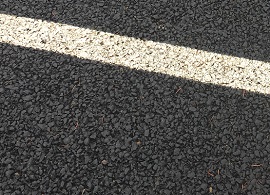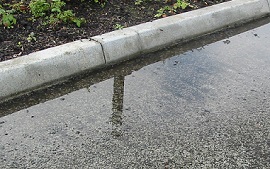Good: Pervious asphalt, note the coarse
appearance.
Pervious Pavement
Pervious pavement allows water to pass through it and soak into the ground, reducing runoff and mimicking the natural hydraulic cycle. Pervious pavement typically is a layer of specially formulated concrete or asphalt on top of a thick layer of gravel (8-24 inches). As water passes through the pavement and gravel, contaminants are filtered out. The water is stored in the gravel layer until it can soak into the ground. Pervious pavement requires regular maintenance to allow water to pass freely.
Maintenance sheets
Permeable pavement (includes pervious concrete/pavement, porous asphalt, permeable pavers, open-celled paving grid with gravel or grass)
Maintenance is needed if you see these signs
Problem: This pervious concrete needsmaintenance; there should be no standing
water.
Standing water during or after rainfall (see photo)
Visible debris or sediment on pavement surface
Moss growth inhibits infiltration or poses a slip safety hazard
Tips for fixing problems and general maintenance
Vacuum and sweep pavement frequently, preferably at least twice a year.
Wash pavement using high pressure water at least once a year. Protect nearby storm drains from wash water.
Do not allow dirt or landscaped areas to drain or erode onto pervious pavement.
Repair and patch pervious pavement with similar pervious material and gravel layer.
Report Spills
Chemical spills such as oil, gasoline, paint or herbicides/pesticides may cause harm to surface or groundwater. Spills MUST be reported to the Washington State Department of Ecology and your local city or county. DO NOT attempt to rinse away the spill until it's been checked.
Washington Department of Ecology 24-hour Spill Response Number: (360) 407-6300

